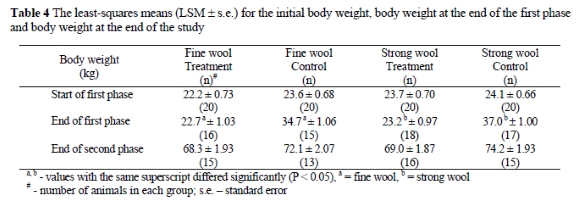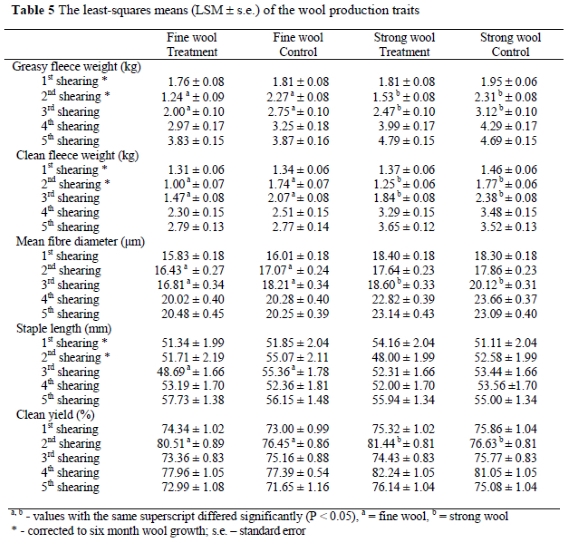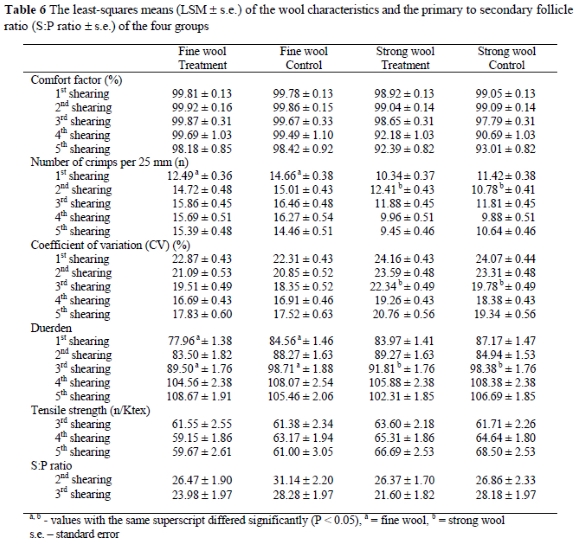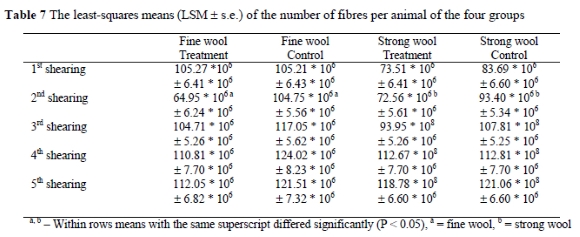Servicios Personalizados
Articulo
Indicadores
Links relacionados
-
 Citado por Google
Citado por Google -
 Similares en Google
Similares en Google
Compartir
South African Journal of Animal Science
versión On-line ISSN 2221-4062
versión impresa ISSN 0375-1589
S. Afr. j. anim. sci. vol.35 no.4 Pretoria 2005
The effect of nutritional stress on the wool production potential of strong and fine wool Merino sheep
W.J. OlivierI, #; J.J. OlivierII
IGrootfontein ADI, Private Bag X529, Middelburg, E.C. 5900, South Africa
IIARC: AII, Private Bag X5013, Stellenbosch 7590, South Africa
ABSTRACT
The objective of this study was to investigate the effect of short-term nutritional stress after weaning on the wool production characteristics of fine vs. strong wool producing Merino sheep over the short and medium term. Forty fine wool and 40 strong wool weaner lambs were divided into two equal groups (treatment and control group) each. The treatment and control groups received diets of low and high nutritional value, respectively, for a period of three months. Thereafter the animals were kept for a further 18 months on natural pasture in the Karoo. After the first three months the body weights of the control groups were more than 12 kg heavier than those of their respective stressed groups. However, these differences in body weight were cancelled out by the end of the experiment due to compensatory growth among the treatment animals after alleviation of the nutritional stress. After the three-month stress period the fine wool group produced 42% less wool than their unstressed control group and the strong wool group only 29% less wool than their control group. However, at the end of the study the stressed animals produced the same amount of wool as their respective controls. The most important conclusion from these results is that early nutritional stress did not have a permanent detrimental effect on the wool production potential of fine or strong wool sheep.
Keywords: Fibre diameter, staple length, wool follicles, body weight
Introduction
The demand for fine wool during the late nineteen eighties has lead to an increase in the number of flocks in South Africa where one of the main breeding objectives was to decrease fibre diameter. Most of these flocks are kept under extensive farming conditions in the semi-arid and arid regions of South Africa. Seasonal droughts occur regularly in these areas, subjecting these animals to nutritional stress.
It is widely known that several wool quality factors such as fibre diameter, fibre length and tensile strength are influenced by the amount of nutrients available to the wool follicles. The amount of wool is in turn influenced by, among others, fibre diameter and fibre length (Reis & Sahlu, 1994). Several researchers have indicated that the effect of nutrition on wool production is mainly expressed through fibre length and diameter (Nichols, 1933; Galpin, 1948; Stewart et al., 1961; Sumner & Wickham, 1969). It is also well known that nutritional stress of ewes during pregnancy will result in less and stronger wool being produced by their progeny. Kelly et al. (1996), for example, found a significant difference in the fibre diameter of cloned animals born to different receiver ewes which have been fed two different quality diets. Hunter et al. (1990) reported that where stress factors, such as nutrition and lambing, were present, fibre diameter was decreased on average by 30%, amounting to a decrease of up to 10 μm in diameter.
Some South African wool producers have a perception that sheep with the genetic potential to produce fine wool are affected more by stress related factors than those producing strong wool. Furthermore, it is believed that the production loss in the fine wool animals would be permanent, while that in strong wool animals is only temporary. The objective ofthis study was, therefore, to investigate the effect of short-term nutritional stress after weaning on the short- and medium-term wool production and wool characteristics of fine vs. strong wool Merino sheep.
Material and Methods
Eighty wether lambs from the Grootfontein Merino flock were used for this study, 40 from a genetic line producing fine wool and 40 from a line producing strong wool. The lambs from each line were allocated randomly into two groups of approximately the same body weight and mean fibre diameter, viz. two treatment and two control groups. The study was carried out in two phases. During the first phase the animals were kept in pens for a period of15 weeks and received two quality diets ad libitum. The treatment groups received a diet of low nutritive value and the control groups one of high nutritive value. When there was no difference in body weight between the respective treatment and control groups after four week, the energy content of the control diet was increased for the rest of this phase. The composition and the estimated nutritive value of the different diets are presented in Table 1.

During the second phase, the sheep were kept as one group for a period of18 months on natural pasture at the Grootfontein Agricultural Development Institute (GADI) near Middelburg (31°28'S, 25°1'E) in the north-eastern Karoo region of South Africa. The GADI is located in the False Upper Karoo (Veld type 36, Acocks, 1988) and has an annual rainfall of 360 mm.
The animals were weighed weekly during the first phase and monthly during the second phase. The sheep were shorn at the commencement and end of the first phase and every six months thereafter for a period of 18 months. At each shearing individual fleece weights were recorded and mid rib fleece samples were taken from each animal for analysis. The samples were used to determine clean yield (CY), clean fleece weight (CFW), mean fibre diameter (MFD), staple length (STPL), number of crimps per 25 mm (Crimps), deviation from the Duerden standard (Duer), coefficient of variation (CV), comfort factor (CF; percentage of fibres below 30 μm) and tensile strength (TS). The tensile strength could not be measured on the wool from the first two shearings because the staple length of the samples was less than 50 mm, which is the minimum length required for this measurement. Fleece weight and staple length of the first and second shearings were converted to a wool growth of 180 days.
A skin biopsy at the midrib area of the animals was taken prior to the second (at the end of the first phase) and third (six months after the end of the first phase) shearings. These biopsies were used to determine the primary to secondary follicle ratio (S:P ratio) of each animal, using an image analyzer (analySIS 3.2 Auto; Soft Imaging System, Münster, Germany).
To determine if there was a difference in the number of fibres between the respective treatment and control groups, the number of fibres per animal (Fib) was calculated, using the following equation:

where: Fib = the number of fibres per animal,
CFW = clean fleece weight (kg),
Sg = the specific gravity of wool (1.31 g/cm3),
r = the radius of the fibre (cm),
l = the length of the fibre (cm).
Least-squares means (LSM) and standard errors (± s.e.) for body weight and wool traits were obtained with the PROC GLM-procedure of SAS, and significance levels between the treatment and control groups of each flock were obtained with the PDIFF-option under the PROC GLM-procedure of SAS (Littell et al., 2002). The fixed effects that were tested for significance for the different traits were age of the dam in years (Dage), flock x group (fine wool or strong wool; control or treatment; FG) and rearing status (combination of birth and weaning status; RS). For each trait the effect of age of the animals (linear regression; Age) was also tested for significance.
The levels of significance obtained for the respective effects for the weekly and monthly body weights and the wool traits are summarised in Tables 2 and 3, respectively. The age of the dam, rearing status and age of the animals were not included for some groups of traits in the respective tables because they did not have a significant effect on any group of traits in that table. The effect of GFW and MFD of the first shearing on subsequent fleece weights and MFD were tested by inclusion as linear regressions. Except for flock x group, only the effects that had a significant effect on a specific trait were included in the final model.


Results and Discussion
The body weights at the commencement of the first phase, at the end of the first phase and at the end of the second phase are given in Table 4, and the changes in body weights, recorded during the first and second phases of this study are depicted in Figures 1 and 2, respectively. From Figure 1 it is evident that the change in the diet of the control groups resulted in marked increases in the body weights of the control groups after week 8 when the animals were well adapted to their new diet. Body weights of the treatment groups remained constant for the duration of the first phase. There was a significant difference of more than 12 kg in body weight between the treatment and control groups of the two flocks at the end of the first phase (Table 4 and Figure 1). After the animals were moved to the veld, there was a marked increase in the growth rate of the treatment groups compared to their respective control groups (Figure 2). No significant differences in body weight were observed between the respective treatment and control groups at the end of the second phase (Table 4).



The LSM (± s.e.) for GFW, CFW, MFD, STPL and CY for the respective shearings are summarized in Table 5. At the commencement of the study there were no significant differences between the treatment and control groups of each flock with regard to any of the wool traits. Nutritional stress had a significant effect on wool production of the treatment groups compared to the respective control groups. Wool production of the fine wool treatment group was affected more negatively than that of the strong wool treatment group. This is illustrated by the fact that the fine wool treatment group produced 42% less wool than their control group, while the strong wool treatment group produced only 29% less wool than their control group. Six months after the stress period ended (3rd shearing), the differences (P < 0.05) in wool production between the respective fine wool and strong wool groups had decreased to 29% and 23%, respectively. At the end of the study the treatment groups produced the same amount of wool as their respective control groups.

At the end of the stress period the fine wool treatment group produced 0.64 μm finer (P < 0.01) wool compared to their control. At the same stage there was no difference in MFD between the strong wool groups. This is a further indication that fine wool sheep are affected more negatively by nutritional stress than strong wool sheep. The significant differences in MFD between the fine and strong wool groups six months after the stress phase had ended, suggest that animals that were subjected to nutritional stress will take some time to recover fully from the stress.
At the end of the first phase both treatment groups had higher (P < 0.01) CY's than their respective control groups. This might be due to the fact that better feeding conditions increased the production of wool yolk (Ryder & Stephenson, 1968).
The LSM of the wool characteristic and S:P ratio analysed in this study are summarized in Table 6. From this table it is evident that nutritional stress did not have an influence on these traits. The exceptions were the higher number of crimps per 25 mm of the strong wool treatment group compared to their control (2nd shearing), as well as the higher CV in the strong wool treatment group (3rd shearing). The differences in Duerden at the 3rd shearing are probably the effect of the differences in MFD, as there were no differences in the number of crimps per 25 mm at that stage. It is evident from these tables that nutritional stress did not effect these traits from the 3rd to 5th and the 2nd and 3rd shearings, respectively.

The differences in MFD and STPL between the respective groups within each flock were relatively small or even non-significant, whereas the differences in the fleece weights were relatively large and significant. Therefore, it is apparent that the small differences in the two most important factors that influence the amount of wool growth, namely MFD and STPL, did not account for the loss in wool production. The reason for the differences in wool production could be due to differences in the activity of the wool follicles, since there were also no significant differences between the S:P ratios in both flocks.
The estimated number of fibres per animal could be used as an indication of the activity of the follicles. The LSM of the number of fibres per animal at each shearing are presented in Table 7. It is clear from this table that there were no significant differences at the commencement of the first phase between the number of fibres of the respective fine wool and strong wool groups. Furthermore, it is clear that the fine wool sheep had significantly more fibres than the strong wool animals at the commencement of the study.

The only significant differences between the respective groups of each flock were evident at the end of the stress phase at the second shearing. The number of fibres per animal of the fine wool treatment group decreased sharply during the stress phase, while that of the respective control group remained almost constant during this phase (Table 7). Furthermore, when the LSM of the fine wool groups are compared to that of the strong wool groups it is evident that the situation was reversed, where the value of the treatment groups remain constant and the number of fibres per animal of the strong wool control group increased. However, there were no significant differences in the number of fibres per animal throughout the second stage (Table 7). This suggests that the follicles of the fine wool treatment group shed their fibres and became inactive for the duration of the stress period, but started to produce fibres again after the stress factor was removed, i.e. when the feeding conditions improved. With regard to the stressed animals in the strong wool group, the stress period stopped the normal increase and development of follicles until the feeding conditions were improved.
It is well-documented that wool follicles can become inactive and shed their fibres as a result of stress factors, such as nutritional stress (Lang, 1945; Lindner & Ferguson, 1956; Lyne, 1964; Chapman & Bassett, 1970; Thwaites, 1972; Schlink et al., 1992; Schlink & Dollin, 1995; Hynd et al., 1997; Thompson et al., 1998). Furthermore, Thompson et al. (1998) reported that the incidence of fibre shedding is higher in young growing animals than in older ones because of their low body reserves of fat and protein, which would thus limit the buffering ability of these nutrients against seasonal fluctuations in the availability of nutrients.
The results from this study suggest that the wool follicles of the stressed animals in both the fine and strong wool flocks became inactive and that some follicles shed their fibres. However, the inactivity of the follicles was not permanent, since at the end of the second phase there were no differences in the amount of wool and the number of follicles produced by the control and treatment groups. Allden (1968) also reported that stress at an early age caused by poor nutrition for a short period did not have a negative affect on the ability of Merino lambs to produce wool.
Conclusion
From the results of this study it is evident that in the long term nutritional stress at an early age did not affect the body weight of young growing lambs negatively. The results furthermore indicated that wool production of fine wool sheep was affected more negatively during the stress period than that of strong wool sheep. However, this negative effect was only temporary, because the difference in the amount of wool produced between the control and treatment groups decreased after the stress was removed. At the end ofthe experiment the fine wool sheep from both experimental treatments produced the same amount of wool, while the stressed animals in the strong wool group produced 3% more wool than the unstressed group.
The results from this study suggest that the wool follicles of the animals of the treatment groups of both the fine and strong wool flocks became inactive and that some follicles shed their fibres. However, a most important factor is that the inactivity of the follicles was not permanent, and at the end of the second phase there were no differences in the amount of wool produced by the stressed and unstressed groups.
It could be concluded that early nutritional stress did not have a permanent detrimental effect on the wool production potential of fine and strong wool sheep.
Acknowledgements
The authors want to express their gratitude to Cape Wools of South Africa for funding the project, the Provincial Veterinary Laboratory at Middelburg, Eastern Cape, for the preparation of the histological slides and the Elsenburg Agricultural Development Institute for the analyses of the histological slides.
References
Acocks, J.P.H., 1988. Veld types of South Africa. (3rd ed.). Memoirs of the botanical survey of S.A., No. 57, Botanical Research Institute, Dept. Agric. and Water Supply, Pretoria, South Africa. [ Links ]
Allden, W.G., 1968. Undernutrition of the Merino sheep and its sequelae. II. The influence of finite periods of arrested growth on the subsequent wool growth, fleece development and utilization of feed for wool production of lambs. Aust. J. Agric. Res. 19, 639-648. [ Links ]
Chapman, R.E. & Bassett, J.M., 1970. The effects of prolonged administration of cortisol on the skin of sheep on different planes of nutrition. J. Endocrin. 48, 649-663. [ Links ]
Galpin, N., 1948. A Study of wool growth. II Mean fibre thickness, density of fibre population, the area of skin covered by fibre and the mean fibre length. J. Agric. Sci. 38, 303-314. [ Links ]
Hunter, L., Van Wyk, J.B., De Wet, P.J., Grobbelaar, P.D., Pretorius, P.S., Morris, J.deV. & Leeuner, W., 1990. The effect of nutritional and lambing stress on wool fibre and processing characteristics. Wool Technol. Sheep Breed. (Sep., 1990 / Oct., 1990 & Dec., 1990 / Jan., 1991), 89-91d. [ Links ]
Hynd, P.I., Hughes, A., Earl, C.R. & Penno, N.M., 1997. Seasonal changes in the morphology of wool follicles in Finewool and Strongwool Merino strains at different stocking rates in southern Australia. Aust. J. Agric. Res. 48, 1089-1097. [ Links ]
Kelly, R.W., Macleod, I., Hynd, P. & Greeff, J., 1996. Nutrition during fetal life alters annual wool production and quality in young Merino sheep. Aust. J. Exp. Agric. 36, 259-267. [ Links ]
Lang, W.R., 1945. Growth in tender wool. J. Text. Inst. 36, T243-252. [ Links ]
Lindner, H.R. & Ferguson, K.A., 1956. Influence of the adrenal cortex on wool growth and its relation to break and tenderness of the fleece. Nature (London) 177, 188-189. [ Links ]
Littell, R.C., Freud, R.J. & Struop, W.W., 2002. SAS-system for linear models, 4th Ed. SAS Institute. Inc. Cary, N.C., USA. [ Links ]
Lyne, A.G., 1964. Effect of adverse nutrition on the skin and wool follicles in Merino sheep. Aust. J. Agric. Res. 15,788-801. [ Links ]
Nichols, J.E., 1933. Fibre growth phases in a sample of Australian Merino wool. J. Text. Inst. 24, T333-T340. [ Links ]
Reis, P.J. & Sahlu, T., 1994. The nutritional control of the growth and properties of mohair and wool fibres: A comparative review. J. Anim. Sci. 72, 1899-1907. [ Links ]
Ryder, M.L. & Stephenson, S.K., 1968. Wool Growth. Academic Press. 562-592. [ Links ]
Schlink, A.C. & Dollin, A.E., 1995. Abnormal shedding contributes to the reduced staple strength of tender wool in Western Australian Merinos. Wool Technol. Sheep Breed. 43, 268-84. [ Links ]
Schlink, A.C., Masters, D.G. & Dollin, A.E., 1992. Effects of animo acids on fibre shedding in reproducing ewes. Proc. Nutr. Soc. Australia. 17, 80. [ Links ]
Stewart, A.M., Moir, R.J. & Schinckel, P.G., 1961. Seasonal fluctuations in wool growth in south western Australia. Aust. J. Exp. Agric. 1, 85-91. [ Links ]
Sumner, R.M.W. & Wickham, G.A., 1969. Some effects of an increased stocking level on wool growth. Proc. N. Z. Soc. Anim. Prod. 29, 208-217. [ Links ]
Thompson, A.N., Schlink, A.C., Peterson, A.D. & Hynd, P.I., 1998. Follicle abnormalities and fibre shedding in Merino weaners fed different levels of nutrition. Aust. J. Agric. Res. 49, 1173-1179. [ Links ]
Thwaites, C.J., 1972. The effects of short-term undernutrition and adrenocortical stimulation on wool growth. Aust. J. Biol. Sci. 32, 317-327. [ Links ]
# Corresponding author. E-mail: willemo@gfn.agric.za














